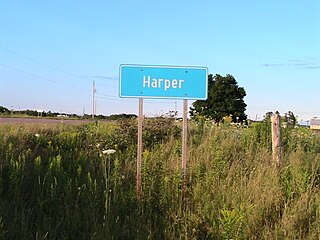
Tignish is a Canadian town located in Prince County, Prince Edward Island.

Skinners Pond is a rural unincorporated community in Prince County, Prince Edward Island, Canada.

Lot 1 is a township in Prince County, Prince Edward Island, Canada created during the 1764–1766 survey of Samuel Holland. It is part of North Parish.
St. Felix is a rural municipality in Prince Edward Island, Canada. It is located in Prince County, 4 km (2.5 mi) south of Tignish.
Alberton is a Canadian town located in Prince County, Prince Edward Island. It is situated in the western part of the county in the township of Lot 5.

Prince County is located in western Prince Edward Island, Canada. The county's defining geographic feature is Malpeque Bay, a sub-basin of the Gulf of St. Lawrence, which creates the narrowest portion of Prince Edward Island's landmass, an isthmus upon which the city of Summerside is located.
Palmer Road is a small community located in Lot 1, in Prince County, Prince Edward Island, Canada that is located on Route 155, Route 156 and Route 158. There are approximately 100 citizens in Palmer Road, and it is located between Tignish and St. Louis, Prince Edward Island. It is also home to the Immaculate Conception Church, and the nearby Palmer Road Community Center. Palmer Road is located 2 mi (3.2 km) northwest of St. Louis, and 6 mi (9.7 km) southwest of Tignish.

Harper is a Canadian rural community located in western Prince County, Prince Edward Island.
Leoville is a Canadian rural community located on Route 158, 3.50–5.00 miles SW of Tignish in western Prince County, Prince Edward Island.
Ascension Road, labelled Route 160, is a 2-lane collector highway in western Prince County, Prince Edward Island, Canada. It is located 2 miles (3.2 km) NW of the community of Tignish. Its maximum speed limit is 80 kilometres per hour (50 mph).
Peter Road, or Peterville Road, labelled Route 159, is a 2-lane collector highway in western Prince County, Prince Edward Island, Canada. It is near the community of Tignish. Its maximum speed limit is 80 km/h (50 mph).
Peterville is a small community located on Route 159 from 2.01 – 3.78 miles SW of Tignish, in the Lot 1 township. Peterville is within the Canadian province of Prince Edward Island, in Eastern Canada. The community is home to Harper's Brook, a tributary to the Tignish River, which runs from Tignish to DeBlois. It is home to approximately 20 people. The name "Peterville" is believed to have come from an explorer, Peters, who visited the area in the 18th century or later.
Pridham Road, labelled Route 154, is a 2-lane collector highway in western Prince County, Prince Edward Island, Canada. It is near the town of Alberton. Its maximum speed limit is 80 km/h (50 mph).

Palmer Road, labelled Route 156, is a 2-lane collector highway in western Prince County, Prince Edward Island, Canada. It is between the communities of Tignish and Miminegash. Its maximum speed limit is 80 km/h (50 mph). The road is considered part of two larger communities, Tignish and Miminegash.
Greenmount Road, labelled Route 153, is a 2-lane collector highway in western Prince County, Prince Edward Island, Canada. It is between the communities of Tignish and Alberton. Its maximum speed limit is 90 km/h (56 mph). The road is considered part of two larger communities, Tignish and Alberton.
Nail Pond is a Canadian rural community in Prince County, Prince Edward Island.

Tignish-Palmer Road is a provincial electoral district for the Legislative Assembly of Prince Edward Island, Canada. It was formerly Tignish-DeBlois from 1996 to 2007.

The Immaculate Conception Church, known colloquially as Palmer Road Church is a 19th-century Roman Catholic church located in Palmer Road, Prince Edward Island, Canada. The church is a white wooden Gothic architecture, and it was constructed in 1892.
Division No. 1, Subdivision C is an unorganized subdivision on the Avalon Peninsula in Newfoundland and Labrador, Canada. It is in Division 1 and contains the unincorporated communities of Cape St. Mary's, Cuslett, Gooseberry Cove, Great Barasway, Lears Cove, Patrick's Cove-Angels Cove, Ship Cove and Stoney House.
Prince Edward Island Route 142, known locally as O'Leary Road, is a 2-lane highway in Prince County, Prince Edward Island, Canada. The highway bisects the island approximately halfway between Summerside and Tignish, and passes through the town of O'Leary.








